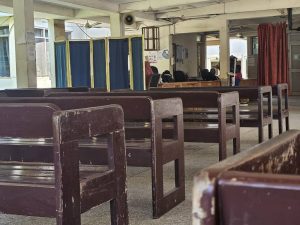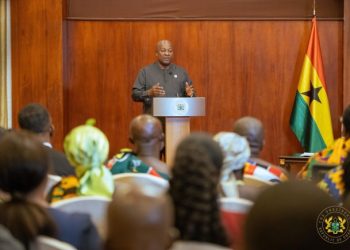Frustrations among patients deepen in various hospitals in the national capital as the ongoing strike by the Ghana National Registered Nurses and Midwives Association (GRNMA) bites harder.
Multiple health facilities visited by The NewsCenta remained open to the general public.
But, many have scaled down operations drastically, attending only to emergency cases and already-admitted patients—and even those are being handled by a skeletal staff under immense pressure.
This crisis is acutely affecting the poorest and most vulnerable Ghanaians—those who cannot afford the high costs of private healthcare.
In emergency cases, doctors are now performing duties typically assigned to nurses, such as recording patient vitals and basic monitoring.
What began as a labour dispute has evolved into a national emergency.
Ga East municipal hospital
At the Ga East Municipal Hospital in Kwabenya, there was a visible absence of nurses, which had compelled other medical professionals, clad in lab coats, to assume triage duties.
Although hospital administrators declined to comment, patients and their caregivers spoke of slower-than-usual service delivery.
A mother named Tumani, who had brought her young son the previous day, recounted how her son developed a fever but was left unattended because, doctors had finished their shift and left.

“Although I saw the doctor earlier on Sunday, by the time I returned from the lab with my test results, the facility had emptied. I had to take him home and get some medication from a pharmacy to control his temperature. I only returned this morning (Monday),” she explained.
Another patient, Michael Agodo, a resident of Kwabenya, said he was unaware of the strike.
“I didn’t know about the strike. I only got here to be told. If I had known about it, I wouldn’t have wasted time coming here,” he lamented, adding that he might have opted for a private facility had he known.
However, another visitor, Kwabena, who came with his daughter, expressed satisfaction with how the hospital was coping.
“As far as I’m concerned, there’s nothing to complain about. They’re managing well,” he said.
GAEC hospital
At the Ghana Atomic Energy Commission (GAEC) Hospital in Haatso—a private facility—healthcare services were proceeding as usual, with nurses and patients seen moving about.
Hospital officials, speaking under anonymity, said there had been no significant change in the volume of patients received.
University of Ghana Medical Centre
At the University of Ghana Medical Centre (UGMC), nurses and other healthcare professionals were observed going about their duties, with no visible disruptions.

However, some patients reported delayed services.
Muhammed Iddrissu, who had travelled from Maamobi, said his physiotherapy appointment—which typically takes about an hour—was significantly delayed.
He attributed this to an influx of patients diverted from other facilities.
“At the time I spoke with him, it was already half past 12,” our reporter noted.
Another patient, Helena, said she had been at the centre for over two hours—an unusually long wait.
Despite these accounts, no undue pressure was observed on the staff or facilities during the visit.
Hospital authorities were not immediately available for comment.
37 Military Hospital
When The NewsCenta arrived at the 37 Military Hospital, the facility was bustling with activity.
Nurses and patients moved through the corridors, and key departments like the Outpatients Department, the Paediatric Emergency Unit, and the Trauma and Emergency Unit were all operational.
Some patients confirmed they had received care, though they could not determine whether there had been an increase in footfall due to the strike.
Korle-Bu Polyclinic
Arriving at exactly 10:40 a.m., The NewsCenta found the usually bustling Korle-Bu Polyclinic unusually quiet.
Only a few health workers were present, and the waiting area had just six individuals.
Despite the strike, a few doctors remained on duty, checking vitals and attending to patients.
Adwoa Konadu, a patient, said there were no nurses present when she arrived and that doctors had taken on their responsibilities.
Doctors on duty declined to speak with The NewsCenta, citing their focus on patient care.
Korle-Bu Teaching Hospital
At about 8:00 a.m., The NewsCenta visited the Korle-Bu Teaching Hospital where patients appeared visibly frustrated, particularly at the Department of Surgery.
There were no nurses present, but some health workers continued to assist with care delivery.
At the Department of Child Health and the Child Emergency Ward, doctors were seen taking over nursing responsibilities, including offering consultations and referring critical cases to the 37 Military Hospital and the Police Hospital.
Prisca Asiedu, who had been waiting since 5:30 a.m., was deeply disappointed when told that all consultations were cancelled and would be rescheduled in two weeks.
“We were told the nurses and doctors were on strike. This has really affected us. What if someone dies because of this? We are pleading with the government to intervene,” she said.
Prisca, referred to Korle-Bu from a private hospital, said the strike had left her uncertain about her next steps.
“I don’t know what to do now. It’s frustrating.”
Another patient, Hassan, who had travelled from La Paz, shared a similar experience.
“We didn’t hear anything from the nurses. We just dropped our cards in the box and waited,” he explained.
Eventually, a staff member—possibly from reception—informed patients around 8:30 a.m. that they should return on June 24 due to the ongoing strike.
“It’s very disturbing,” he said, adding that he had also been referred from another facility and was worried about the delay in care.
Barnor Hospital
To assess the spillover effect of the strike, The NewsCenta visited Barnor Hospital, a private facility, where patient numbers had noticeably increased.
Gwen Ofori, a patient, remarked on the surge.
“As compared to normal days, today I’ve seen a lot of patients trooping in. Most of them have been referred from Korle Bu and some nearby polyclinics,” she said.
However, not all areas of the hospital saw a difference.
Wendy Appiah, who visited for physiotherapy, reported that her section had not experienced any increase.
“I come here often for physio, and for where I was today, the numbers are still the same,” she said.











